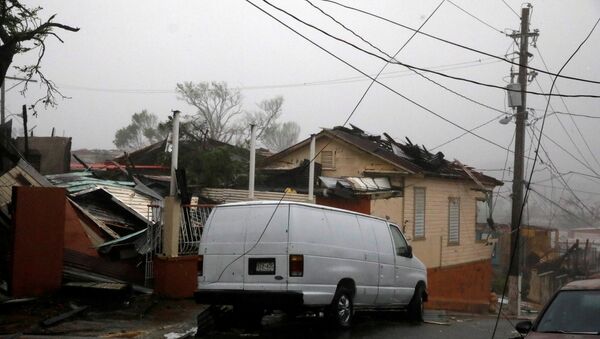— valentino (@vlnto) September 20, 2017
"This is total devastation," Carlos Mercader, a spokesman for Puerto Rico's governor, said in a statement. "Puerto Rico, in terms of infrastructure, will not be the same… this is something of historic proportions."
According to the National Hurricane Center (NHC), the monstrous storm made landfall near the city of Yabucoa with winds turning at 155 mph — nearly enough to be classified as Category 5 — but by 11 a.m. wind speed had dropped to 140 mph. Despite the slight decrease, Maria still has the force to rip off roofs and cause mass damage.
— Rosaline Cabrera (@rosalinetweets) September 20, 2017
One of the concerns officials had prior to Maria's expected arrival was the ability of Puerto Rico's fragile power grid to stay operational.
The Island of Enchantment had lost roughly 90 percent of its electricity once the storm's eye closed in on the region, but it has since lost all power, according to Abner Gómez, head of PR's disaster management emergency.
— Radio Isla 1320 (@radioislatv) September 20, 2017
Moving at a pace of 12 mph, Maria is predicted to cause a storm surge of six to nine feet and drop at least 12 to 18 inches of rain in Puerto Rico, with isolated totals of 25 inches or more.
The NWS-San Juan issued a flash flood emergency early Wednesday for the Rio de la Plata basin after Maria's intensity caused water levels to rise by 20 feet, the Weather Channel reported.
— Emily Atkin (@emorwee) September 20, 2017
At 3 p.m., 18 of 27 river gauges in Puerto Rico reported floods — 10 of those were marked as "major flooding."
— Luis De Jesús (@ldejesusreyes) September 20, 2017
Scheduled to leave Puerto Rico by Wednesday night, the storm will travel towards the Turks and Caicos Islands and the southeastern Bahamas by Thursday, just scraping past the Dominican Republic, according to the NHC. Turks and Caicos residents will see worsening conditions Thursday morning with hurricane winds expected to pound the British Overseas Territory by Thursday evening.
— RUBEN SERRANO (@GUARETO1) September 20, 2017
"At this point, it looks like Maria will miss the United States and will move out to sea sometime later next week," Max Golembo, ABC News' senior meteorologist, said Thursday. "But this will be a close call, so we will be watching carefully."
— WEATHER/ METEO WORLD (@StormchaserUKEU) September 20, 2017
Current forecast models show the storm will travel east of Florida and the Carolinas as fellow cyclone Hurricane Jose pulls Maria away from the US mainland. However, if Jose weakens too quickly, Maria could inch closer to the US coast by the following week, the Washington Post reported.
Since barreling through multiple Caribbean islands including Dominica, Guadeloupe and the Virgin Islands, early reports indicate several people have died due to the powerful storm.

